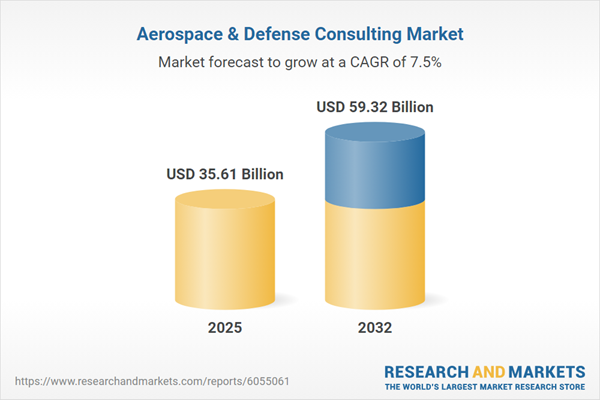Speak directly to the analyst to clarify any post sales queries you may have.
The aerospace and defense consulting market is characterized by rapid technological advancement, complex regulatory demands, and evolving global risk factors. Senior leaders need actionable insights and strategic guidance to navigate emerging challenges and capitalize on transformational opportunities within this dynamic sector.
Market Snapshot: Aerospace & Defense Consulting Market Size and Growth
The Aerospace & Defense Consulting Market grew from USD 33.29 billion in 2024 to USD 35.61 billion in 2025, with expectations to achieve a compound annual growth rate (CAGR) of 7.48%, reaching USD 59.32 billion by 2032. This sustained expansion reflects ongoing demand for high-value advisory services in digital transformation, procurement, and operational resilience, driven by both innovation and increased geopolitical complexity.
Scope & Segmentation of the Aerospace & Defense Consulting Market
- Service Types: Digital transformation and IT consulting; mergers and acquisitions advisory; operational efficiency consulting; regulatory and compliance advisory; risk and security management; strategy and business development; supply chain management.
- Applications: Aircraft manufacturing and maintenance; cybersecurity and defense technologies; defense procurement and logistics; government and military strategy; satellite and space systems advisory.
- End-Users: Aerospace manufacturers; airlines and aviation service providers; defense contractors; government and military agencies; space exploration organizations.
- Regions & Sub-Regions: United States, Canada, Mexico, Brazil, Argentina, Chile, Colombia, Peru, United Kingdom, Germany, France, Russia, Italy, Spain, Netherlands, Sweden, Poland, Switzerland, United Arab Emirates, Saudi Arabia, Qatar, Turkey, Israel, South Africa, Nigeria, Egypt, Kenya, China, India, Japan, Australia, South Korea, Indonesia, Thailand, Malaysia, Singapore, Taiwan.
- Leading Companies: A.T. Kearney, Accenture, AlixPartners, Argon Consulting, Arthur D Little, Ayming, Bain & Company, Boston Consulting Group, Capgemini, CGI, Ernst & Young, FTI Consulting, HCL Technologies, Kearney, Korn Ferry, KPMG, L.E.K. Consulting, Lucideon, McKinsey & Company, PA Knowledge, Pinnacle Management, PwC, Protiviti, Roland Berger, TNP Consultants, Vendigital.
Key Takeaways for Senior Decision-Makers
- The ongoing integration of artificial intelligence and advanced analytics is transforming consulting deliverables, enabling real-time asset simulation and predictive maintenance strategies.
- Heightened geopolitical shifts and tightened budgets are driving defense clients to reassess risk frameworks, implement resilient supply chains, and adapt procurement practices.
- Advisory firms are moving beyond traditional roles to function as digital system integrators, embedding secure cloud architectures and advanced analytics into client operations.
- Emerging regulatory focus on sustainability is prompting new consulting mandates, including lifecycle impact assessments and green supply chain modeling.
- Segmentation by region and end-user highlights varied demand: the Americas emphasize modernization, EMEA focuses on joint procurement, and Asia-Pacific accelerates digital and space-related capabilities.
- Competitive advantage increasingly depends on capabilities in cross-functional collaboration, digital technology integration, and multidisciplinary expertise.
Tariff Impact on Aerospace & Defense Consulting Value Chains
Recent U.S. tariffs introduced in 2025 have redefined sourcing strategies across aerospace and defense projects, pushing consulting clients to explore nearshoring and recalculate local content requirements. Advisory teams are enhancing scenario planning for supply chain disruptions, inventory management, and compliance challenges. This evolving environment encourages cross-functional approaches involving procurement, finance, and risk-management experts to maintain operational continuity.
Primary Keyword: Aerospace & Defense Consulting Market
Methodology & Data Sources
The findings in this report are built on a combination of primary interviews with C-level executives, subject matter experts, and policymakers, alongside a comprehensive review of government publications, technical journals, and industry white papers. Data triangulation and expert panel reviews underpin the consistency and reliability of the conclusions.
Why This Report Matters
- Enables senior leaders to anticipate market shifts and prioritize investment in digital transformation, operational resilience, and sustainable consulting services.
- Equips organizations with concrete recommendations to diversify supply chains, foster organizational agility, and strengthen compliance amidst volatile global conditions.
- Delivers in-depth segmentation and competitive benchmarking to inform robust strategic decision-making across regions and specialized consulting domains.
Conclusion
The Aerospace & Defense Consulting Market requires strategic foresight and adaptable frameworks to address regulatory, digital, and geopolitical complexities. Organizations leveraging robust insights and data-driven planning position themselves to thrive in this evolving advisory landscape.
Table of Contents
3. Executive Summary
4. Market Overview
7. Cumulative Impact of Artificial Intelligence 2025
Companies Mentioned
The companies profiled in this Aerospace & Defense Consulting market report include:- A.T. Kearney, Inc.
- Accenture PLC
- AlixPartners, LLP
- Argon Consulting S.A.S
- Arthur D Little
- Ayming
- Bain & Company, Inc.
- Boston Consulting Group
- Capgemini Services SAS
- CGI Inc
- Ernst & Young Global Limited
- FTI Consulting, Inc
- HCL Technologies Limited
- Kearney, Inc
- Korn Ferry
- KPMG Assurance and Consulting Services LLP,
- L.E.K. Consulting LLC
- Lucideon
- McKinsey & Company
- PA Knowledge Limited
- Pinnacle Management Systems, Inc.
- PricewaterhouseCoopers International Limited
- Protiviti Inc.
- Roland Berger GmbH
- TNP Consultants
- Vendigital Limited
Table Information
| Report Attribute | Details |
|---|---|
| No. of Pages | 181 |
| Published | November 2025 |
| Forecast Period | 2025 - 2032 |
| Estimated Market Value ( USD | $ 35.61 Billion |
| Forecasted Market Value ( USD | $ 59.32 Billion |
| Compound Annual Growth Rate | 7.4% |
| Regions Covered | Global |
| No. of Companies Mentioned | 27 |









